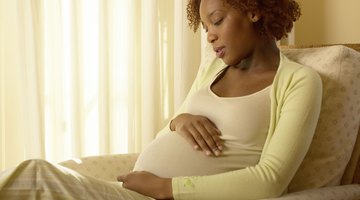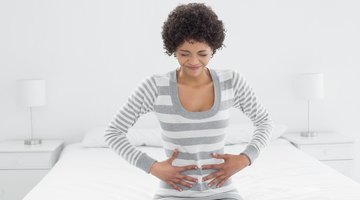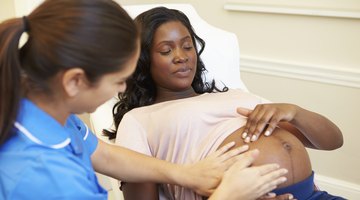Causes of Menstrual-Like Cramping at 33 Weeks Pregnant
Pain in the abdominal area during pregnancy, including menstrual-like cramps, can be startling. There are a few perfectly safe explanations for late pregnancy cramping, such as that which occurs during the 33rd week.
In some cases, menstrual cramping at this late stage of pregnancy can be a sign of a serious complication. Always contact your health care provider if you notice menstrual-like cramping during your pregnancy, especially if it is persistent or is accompanied by any other symptoms.
Ligament Stretching
At any point during and after the second trimester a woman may notice mild to moderate cramping that spans the abdominal area. This feeling may feel similar to a pulled muscle but will diminish after a few seconds or when the motion is discontinued. This is called ligament pain. The ligament is the tough band of tissues that is connected to the muscle and the uterus, says the March of Dimes.
This pain occurs when a woman moves, such as getting out of bed. The pain may start in the pelvic area and spread to the abdominal area. When the pain reaches the abdominal area, it may feel like menstrual cramps. Ligament pain does not last for very long. If you have pain that feels like this for more than just a few seconds or minutes, contact your doctor.
Labor

Seven Months Pregnant With Random Contractions
Learn More
Irregular contractions, often called Braxton-Hicks contractions, can occur during the 33rd week of pregnancy. These contractions can feel like menstrual-like cramping or they may be painless. The uterus and surrounding muscles become firm from the contraction. False labor cramps can increase in frequency and intensity as the pregnancy progresses.
One way to differentiate false labor from real contractions is to walk. Walking will not interrupt real contractions, but false labor contractions may stop when you begin moving. Real labor contractions will become predictable. Timing them is another way to determine if they are real or false. False contractions may occur on an irregular time pattern.
Real contractions are a consistent number of minutes apart and last about the same amount of time. In real labor, the contractions will steadily increase in time and they will be closer together. The 33rd week is considered to be preterm labor, says the March of Dimes.
It is important to contact your doctor right away if you suspect that you are having real contractions. Real contractions may be accompanied by leaking fluid or blood from the vagina, a low backache that is dull and the contractions are usually similar to menstrual cramps.
Placental Abruption
Placental abruption is a very serious and dangerous condition that can occur late in pregnancy, including the 33rd week. Abruption refers to the separation of the placenta from the uterus, says BabyCenter.com. The separation can be partial or complete. Symptoms of placental abruption can vary.
Some women may have sudden bleeding that is obvious or it may be gradual. If your water breaks after the abruption has occurred, the fluids may be full of blood. Pain associated with placental abruption can feel like menstrual cramping that does not go away. The baby may stop moving and you may have back pain.
Preeclampsia

Causes of Light Bleeding During the First Month of Pregnancy
Learn More
Serious cases of preeclampsia may be accompanied by intense pain or tenderness in the upper abdomen, says BabyCenter.com. Most women are diagnosed with preeclampsia by week 20 of the pregnancy. This condition is characterized by changes in the blood vessels that can impact many organs in the body, including the liver, brain and the placenta.
High blood pressure and protein in the blood are two traits a woman's blood will have, if she has preeclampsia. Other symptoms with the cramping can include swelling of the face, hands or feet and ankles. More serious symptoms can include a severe headache, vision problems (blurred vision or seeing spots), nausea and vomiting.










